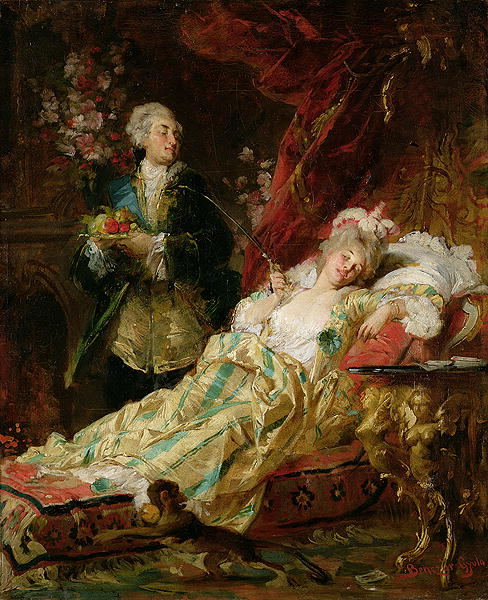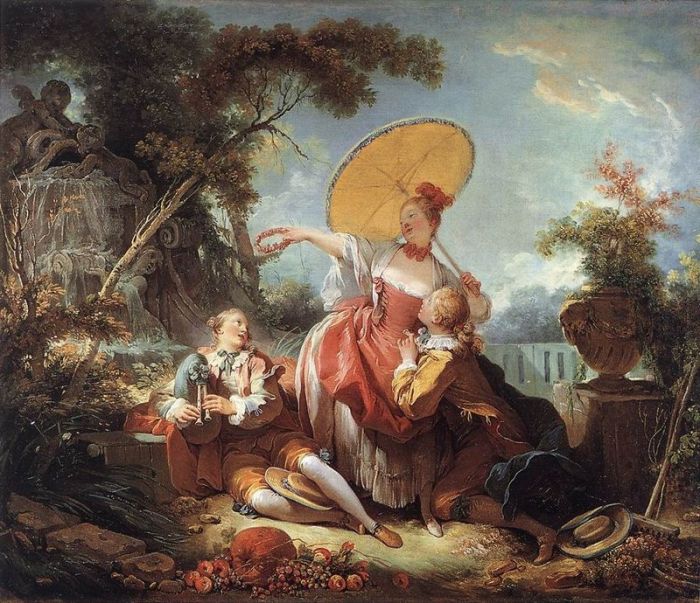Abie Smith

Madame du Barry by Vigée Le Brun (1781)
Jeanne Bécu, comtesse du Barry was Louis XV’s final Maîtress-en-titre from 1769 until the King’s death in1774. She was born on 19 August, 1743 to an unmarried seamstress. As a child she briefly attended a convent school but spent most of her teenage years working as milliner’s assistant, a job which was closely associated with prostitution at the time. In 1763 Du Barry caught the attention of a pimp named Jean-Baptiste du Barry, and he took her on as his mistress while simultaneously establishing her career as a courtesan. Her clientele included many of Paris’s most influential men, and tales of her sublime beauty swarmed around them. The Maréchal de Richelieu was one of Du Barry’s best clients, and she often accompanied him to court at Versailles. Recognizing that she had caught the King’s attention, Jean-Baptiste saw an opportunity to increase his political power by installing Jeanne as a courtesan at Versailles. In order to be Louis XV’s maitress-en-titre Jeanne needed to be married and to have a title, so Jean-Baptiste married her off to his brother, Comte Guillame du Barry. Even after Jeanne was positioned in a suitable marriage with a title, she had considerable difficulty finding someone to sponsor her at court. Most of the aristocrats were scandalized by her past as a prostitute to put it lightly. Finally, Jeanne-Baptiste managed to find an older lady, Madame de Bern, with gambling debts that needed to be paid off. Although her presentation at court was delayed several times due to Madame de Bern’s anxiety over being publicly associated with Madame du Barry, she was finally presented at court as the new maîtress-en-titre to replace Madame du Pompadour on 22 April 1769. Once at Versailles, Du Barry’s interest in politics grew, and she worked closely with other nobles to limit the influence of the pro-parliament factions under the duc de Choiseul. This did not earn her many fans, including Marie Antoinette, whose marriage to the dauphin was largely orchestrated by Choiseul. Du Barry stayed at Versailles until Louis XV died, at which point she was exiled to a convent. She was executed by the revolutionary government in 1793 after reporting that her diamonds were missing or stolen (Haslip 125).

portrait by Francois-Hubert Drouais
Du Barry lived during a time period in France that was rife with social, political, and economic change. Mid-eighteenth century France was alive with Enlightenment thought. In Paris’s salons, men and women alike spoke of scientific objectivity, individual liberty, and inalienable rights. While these new, high ideals captured a portion of the popular French imagination, its other half was engaged by something more vulgar. Gossip pamphlets, known as libelles, were incredibly popular among France’s working and middle classes. Libelles disseminated wildly absurd stories about France’s nobility and royalty and painted them as sex-crazed, greedy fiends. Advancements in printing and transportation made it easier for publishers to disseminate the pamphlets than ever before. While few among the court at Versailles were spared the libelles’ wrath, Marie Antoinette and Madame du Barry caught the majority of the pamphlets’ criticisms. Although much has been written about the popular media’s depictions of Marie Antoinette, few have taken the time to explore why the press attacked Du Barry so voraciously. Those who have seem to blame it on Du Barry’s background as a prostitute. However, Du Barry was not in fact the political schemer who used her sexuality to persuade the King and influence policy decisions as the libelles described her. In reality, the far-fetched legends propagated by the libelles about Du Barry tell the modern reader more about pre-revolutionary attitudes regarding female sexuality and power than they do about Du Barry as a person. In the pre-revolutionary French press, Du Barry embodied the middle class’s beliefs about the consequences of unbridled female sexuality.

English engraving of French “gutter press” as libelle and nouvelle publishers were called
La Gazetier cuirassé by Charles Théveneau de Morande and Mémoires secrets by Louis Petit de Bachaumont were two popular works of gossip literature that frequently relayed sensational stories concerning Du Barry’s sexual exploits, her unbridled influence over Louis XV, and her voracious spending. La Gazetier cuirassé belonged to a subcategory of French gossip literature known as libelles. Libelles first gained popularity during the French wars of religion in the late sixteenth century. They started as small pamphlets containing a few paragraphs of scandalous material, but by Du Barry’s day had evolved into book –length works. In La Gazetier cuirassé, Morande describes Du Barry as having “passed directly from the brothel to the throne, toppling the most powerful and redoubtable minister, overthrowing the constitution of the monarchy” through her “incredible luxury, insolent talk, and… vainglorious extravagance” (Darnton 35). Mémoires secrets, on the other hand, was a collection of newsletters that were a little less salacious than libelles, as they reported on art, culture, and politics as well news about the aristocracy (Merrick 71). Both Morande and Bachaumont were middle class writers and publishers. While it is a bit of a stretch to claim that the stories and ideas contained in both of these works are representative of a popular pre-revolutionary French consciousness, given the similarities between the authors and publishers backgrounds, it is possible that the attitudes expressed in the literature reflect those commonly held among middle class French men.

Du Barry and Louis XV, decadent and relaxed
In early modern France, fathers and kings exercised similar kinds of authority within their respective domains. So when his subjects began to doubt whether or not Louis XV could control his mistress, they also began to doubt whether or not he was capable of managing the country. For the French, “the family was regarded as a miniature kingdom, and the kingdom was regarded as an extended family” (Merrick 68). Popular enlightenment philosophers like Rousseau supported these ideas about gender relations within the family, by arguing that “the health of the body politic demanded the confinement of women, as chaste wives and mothers, to the domestic sphere” (Maza 167). La Gazetier cuirassé and Mémoires secrets characterized Louis XV as being too decadent and too much of a lush to sufficiently rule his people. After ousting Choiseul, Morande wrote that Du Barry’s political influence in France included “not only the grands of the kingdom and the ministers, but the princes of the royal blood, foreign amabasadors, and the church itself, which canonizes her scandals and her debauchery” (Darnton 35).

The Musical Contest by Jean-Honore Fragonard (1755) shows two young French men vying for a woman’s attention
Concern regarding unbridled female sexuality was not limited to pre-revolutionary gossip columns. Prior to Du Barry’s installation at Versailles, the early modern French government had a long history spanning over two hundred years of regulating women’s sexual activity outside of marriage. A 1556 royal edict required unmarried women to officially declare their pregnancies. Women who failed to do so and whose children died before baptism faced the death penalty. (Weisner-Hanks 67). In 1658, Louis XIV criminalized prostitution, fornication, and adultery by women. The women’s prison Salpêtrière housed those who were found guilty of these crimes, and inmates were released only after they were determined to be sufficiently penitent by priests. Women’s imprisonment at Salpêtrière for sex crimes marks the first time prison was used as punishment in Europe instead of merely a place to hold people (Weisner-Hanks 69). Marriage out of wedlock, prostitution, and adultery transformed the sex act, which in the minds of traditionalists was meant to stay confined to a married couple’s bed chamber, from a private act to an issue of great public concern. Although these issues almost certainly caused strife within communities for prior to the early modern period, they were perhaps of greater concern to early modern governments due to increased urbanization during the period. With more people living in closer proximity to each other than ever before, communities had to develop new ways of handling old issues. At the dawn of capitalism and its accompanying urbanization, rulers targeted female sexuality as the root of civic strife. With such legal precedent in mind, pre-revolutionary gossip columns built on a long French tradition of regulating public female sexuality.
Contemporaries spoke of Du Barry as if she was the most licentious person to ever exist and whose sexual and moral depravity caused the French monarchy’s collapse. In fact, she was a very normal woman who happened to be around when people needed a scapegoat. Du Barry was not exceptional as far as the lives of courtesans were concerned. Aristocrats procured courtesans to install at court in order to do their political bidding for them. Instead, the press exaggerated stories and rumors about her in order to make larger points about the supposed need to regulate female sexuality within French society.
Works Cited
Darnton, Robert. The Literary Underground of the Old Regime. Cambridge: Harvard University Press, 1982.
Haslip, Joan. Madame du Barry: The Wages of Beauty. New York: Grove Weidenfeld, 1991.
Maza, Sarah. Private Lives and Public Affairs: The Cause Célèbres of Prerevolutionary France. Berkeley: University of California Press, 1993.
Merrick, Jeffrey. “Sexual Politics and Public Order in Late Eighteenth-Century France: The Mémoires Secrets and the Correspondance Secrète.”Journal of the History of Sexuality 1 (1990): 68-84.
Weisner-Hanks, Mary E. “The Female Life Cycle” in Women and Gender in Early Modern Europe. 55-100. Cambridge: Cambridge University Press, 2008.